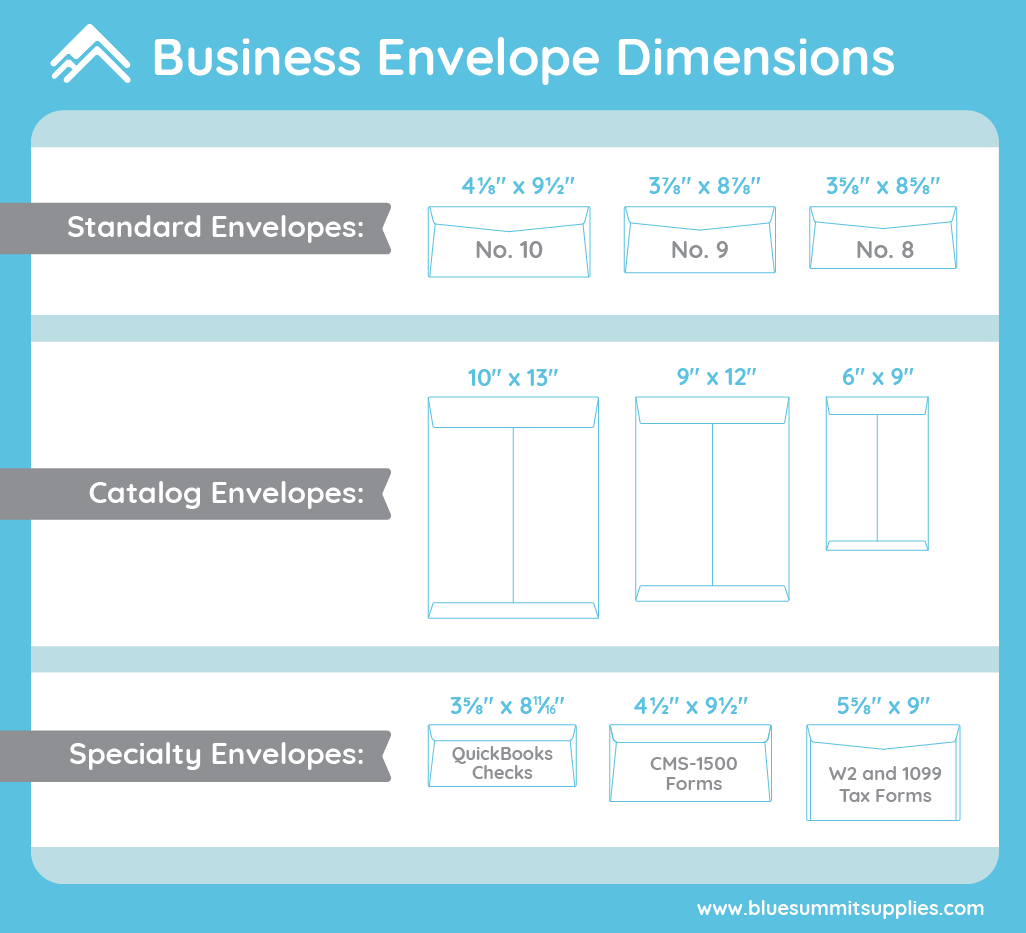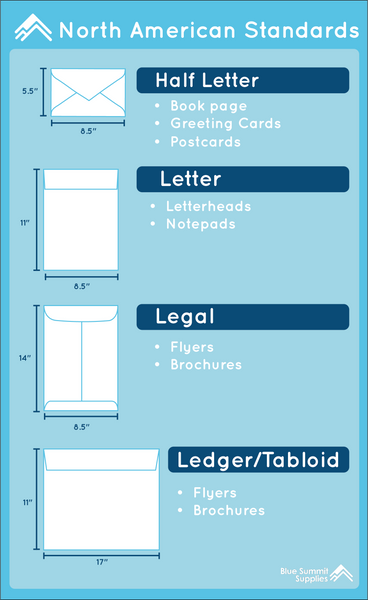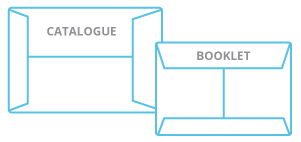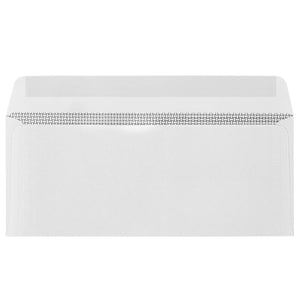Finding the perfect envelope isn’t always straightforward, so we’ve put together a comprehensive guide to make it simple. Read on to take a deep dive into envelope sizing, seals, materials, and more.
Envelope Sizing
If you’re unfamiliar with envelopes, wrapping your head around sizing terms and standardizations can be overwhelming. We’re here to help.
Envelopes for Business
Here’s a quick size chart to help you at a glance.

A good rule of thumb is envelope sizes are denoted by the shortest dimension first, which, for standard business envelopes, is their height. The second measurement is the width of the envelope, which is the longer edge.
The most commonly used business envelope is the #10 envelope. Its size is standardized at 4-1/8” x 9-1/2”. These envelopes fit a sheet of letter-sized paper folded into thirds, trifold style.
The #10 is a 10/10
 If you’re looking for an envelope to use for basic needs, the #10 is likely your guy. This is the most popular envelope for correspondence, both personal and professional, and tends to be the most cost-effective. Ready to grab some? We’ve got you covered.
If you’re looking for an envelope to use for basic needs, the #10 is likely your guy. This is the most popular envelope for correspondence, both personal and professional, and tends to be the most cost-effective. Ready to grab some? We’ve got you covered.
But the #10 envelope isn’t the only one used in business.
There are three basic categories of business envelopes: standard envelopes, large envelopes, and check and form envelopes.
Standard envelopes are the traditional business envelopes used for business mailings (like our friend, the #10) that fit letter-size pages.
 Size Matters
Size Matters
When choosing your envelope, make sure it measures a quarter of an inch wider than its contents. This will prevent unnecessary tearing, tugging, or finagling when trying to insert or remove the contents.
Large envelopes are generally used for sending collateral that can’t be bent or folded or is too bulky to slide into a standard-size envelope. Just like when mailing in a standard envelope, make sure to choose a large envelope that is at least ¼ of an inch larger than its contents.
The three most common large envelope sizes are:
Envelope Dimensions |
Typical Usage |
|
10 in. x 13 in. |
|
|
9 in. x 12 in. |
|
|
6 in. x 9 in. |
|
Booklet or Catalogue, Which is Best?
Oftentimes booklet and catalogue envelopes get conflated, but there is a difference! Catalogue envelopes open on the narrow top and have a seam down the center of the envelope’s back. They’re most commonly used for transferring documents by hand, within offices or from meeting to meeting, though they can also be mailed.
Booklet envelopes open along the wide top and are necessary when mailing items that can’t be bent, folded, or otherwise manipulated into a too-small envelope.

But what kind of postage do you use on a large envelope? According to our own Rachel Eubanks,
“Stamps should be your second choice. Instead, use metered mail or a service like Stamps.com as your first mailing option if you mail large volumes.”
Metered Mail
Metered mail postage is printed directly onto the outer envelope or can be printed onto a label by a postage meter. Postage meters have scales that determine the exact postage required, so you’ll never have to guess on stamps and risk overpaying. Metered mail also offers business an easy way to track mail expenses by department or campaigns, so you can keep an eye on analytics for determining ROI and budget. Plus, it saves you time and money by eradicating the need for repeat trips to the post office.
To note: You can’t purchase your own postage meter since the U.S. government regulates postage. Instead, you must rent your postage meter from an authorized company. To learn more about renting your own postage meter, this article by Expert Marketing is full of helpful info.
Stamps.com
Stamps.com is a service that offers an alternative to metered mail while still offering more savings than traditional stamps – no expensive postage meter needed. You use these services to print postage directly onto envelopes or labels using your office printer or something like a DYMO thermal label printer.
Stamps.com also integrates with fulfillment platforms like ShippingEasy, ShipStation and others. If you sell products online that need to be shipped to customers, this is a great solution. These FAQs by Stamps.com provide helpful insight into their services.
USPS
If you don’t mail large envelopes often, you can simply take the manual approach and avoid the monthly fees or setup costs associated with the options above. We’ve provided a helpful size guide to give the dimensions for “flats,” or large envelopes.
Did you know?
Envelope measurements are most often named by approximation for easy reference. For example, the #10 envelope is just 9-1/2” wide, not 10. But ‘number ten’ is much easier to remember!
Type of Envelope |
Envelope Dimensions |
Typical Usage |
|
Number 10 Envelope |
4-1/8 in. x 9–1/2 in. |
|
|
Number 9 Envelope |
3–7/8 in. x 8–7/8 in. |
|
|
Number 8 Envelope (also called an 8-5/8" envelope) |
3–5/8 in. x 8-5/8 in. |
|
Check and form envelopes are envelopes sized with specific documents in mind. Some examples of the most commonly mailed business envelope ‘anomalies’ are CMS forms, tax forms, and check envelopes. We’ve compiled a quick reference chart of the most popular types of each to give you a better idea on what envelopes you’ll need when.
Type of Envelope |
Envelope Dimensions |
Window Placement |
|
QuickBooks Checks |
3-5/8 in. x 8-11/16 in. |
|
|
CMS-1500 Forms |
4-1/2 in. x width 9-1/2 in. |
|
|
1099-MISC Tax Forms |
5-5/8 in. x 9 in. |
|
|
W2 Tax Forms |
5-5/8 in. x 9 in. |
|
Envelope Sizing Across the World
Not all envelopes everywhere are created the same. Envelope sizing differs from region to region, and depending on where you are in the world, you’ll encounter different options.
It all comes down to paper size.
In North America, our paper sizes are standardized and referred to by terms like Letter, Legal, Tabloid, and Executive.

| North American Standard Paper Sizes | ||
| Paper Size | Dimensions | Typical Usage |
| Half Letter | 8.5" x 5.5" | Book pages, greeting cards, postcards |
| Letter | 8.5" x 11" | Letterheads, print & copy paper, notepads |
| Legal | 8.5" x 14" | Flyers, brochures |
| Ledger(also known as ledger or tabloid) | 11" x 17" | Posters, magazines, publications |
This sizing isn’t common anywhere else in the world.
As we mentioned in a previous post,
“Nearly every other part of the world uses the ISO 216 and ISO 269 standard paper sizes, which are split into A, and B, whereas the C category denotes envelopes. A4 is the most commonly used paper size everywhere except for North America, where we don’t use the ISO 216 or ISO 269 as standard. A4 paper is comparable to our letter-size paper, though the dimensions are slightly different.
Here’s where the letters and numbers come in.
Instead of connoting sizes with names like Legal, Letter, etc. the ISO 216 & ISO 269 standards split paper and envelope sizes into alphanumeric identifiers – like A1, B2, C3. That’s why a C4 envelope size is different than a C5 envelope size even though their names are so similar.
Each size has its own dimensions down to the tenth of an inch and are measured most commonly in millimeters. We’ve provided a handy paper types size chart to make it easier to understand ISO 216 & ISO 269 standard paper sizing.”

| ISO 216 Standards: A Series Sizes | |
| Paper Size | Dimensions |
| A0 | 841 mm × 1189 mm |
| A1 | 594 mm × 841 mm |
| A2 | 420 mm × 594 mm |
| A3 | 297 mm × 420 mm |
| A4 | 210 mm × 297 mm |
| A5 | 148 mm × 210 mm |
| A6 | 105 mm × 148 mm |
| A7 | 74 mm × 105 mm |
| A8 | 52 mm × 74 mm |
| A9 | 37 mm × 52 mm |
| A10 | 26 mm × 37 mm |

| ISO 216 Standards: B Series Sizes | |
| Paper Size | Dimensions |
| B0 | 1000 mm × 1414 mm |
| B1 | 707 mm × 1000 mm |
| B2 | 500 mm × 707 mm |
| B3 | 353 mm × 500 mm |
| B4 | 250 mm × 353 mm |
| B5 | 176 mm × 250 mm |
| B6 | 125 mm × 176 mm |
| B7 | 88 mm × 125 mm |
| B8 | 62 mm × 88 mm |
| B9 | 44 mm × 62 mm |
| B10 | 31 mm × 44 mm |

| ISO 269 Standards: C Series Sizes | |
| Envelope Size | Dimensions |
| C0 | 917 mm × 1297 mm |
| C1 | 648 mm × 917 mm |
| C2 | 458 mm × 648 mm |
| C3 | 324 mm × 458 mm |
| C4 | 229 mm × 324 mm |
| C5 | 162 mm × 229 mm |
| C6 | 114 mm × 162 mm |
| C7 | 81 mm × 114 mm |
| C8 | 57 mm × 81 mm |
| C9 | 40 mm × 57 mm |
| C10 | 28 mm × 40 mm |
| Examples of how ISO page sizes are used | |
| Size | Typical Usage |
| A0, A1 | Technical drawings, posters |
| A2, A3 | Drawings, diagrams, large tables |
| A4 | Letters, Magazines, forms, catalogs, print & copy paper |
| A6 | Postcards |
| A5, B5, A6, B6 | Book pages |
| C4, C5, C6 | Envelopes for A4 letters (either unfolded, folded once, or folded twice, respectively) |
Envelope Styles
As mentioned above, the most common business envelope is the #10 envelope which comes with a commercial flap. However, there are other flap and fold options – square, wallet, side seam, and policy.
When it comes to invitations and greeting cards, the most traditional is baronial. The baronial is squarer than the business envelope and has a ‘half-diamond’ shaped flap.
Similarly, an announcement envelope – predictably used for announcements – has a more squared body but a clear, rectangular flap. These follow the A-style sizing chart listed here.
There are also fully squared envelopes, which are not a standard size and can require special or extra postage to mail. These stand out from other mailings and can be used for anything from invitations to promotional mailers.
Catalogue and booklet envelopes are made to send thicker, bulkier materials, as the names suggest. Collateral like catalogues, booklets, pamphlets, packets, and other thick documents are sent in these secure and oversized envelopes.
For a complete chart of sizes for each, reference our appendix here.
Windowed Envelopes: What, Why, and How
Windowed envelopes are the envelopes we’re most accustomed to seeing in our mailboxes, especially when it comes to deliverables like bills and sensitive documents. The windows make sending out mail en masse simpler, since they require no effort with addressing – the addresses are printed straight onto the inner documents.
Consider Your Options
Windowed envelopes come in both single- and double-windowed designs. The placement of the windows varies, though generally single-windowed envelopes have a window over the recipient’s address and double-windowed envelopes have a window over both the recipient and sender’s addresses.

They can also be better for security, since many windowed envelopes come lined with a security pattern. A security pattern darkens and obscures the contents within the envelope, making it impossible to read the contents through the envelope itself.
Windowed envelopes can be tricky to use since all the information must be visible when they’re sealed. Following the USPS requirements is a way to make sure everything is in place.
- Every character must be visible
- The address must be printed on light-colored paper
- There must be a clear 1/8-inch space between the text and the edge of the window during the entire mailing process
- The window cannot come more than 1/8 inch into the bar code space
- The window cover must be composed of transparent material in order to clearly read the content
- The bottom edge of the window must be at minimum ½ inch from the bottom edge of the envelope

A Quick QuickBooks Windowed Envelope Overview
When it comes to QuickBooks checks, not all windowed envelopes will do. You’ll have to find ones sized correctly; specifically, sized at 3-5/8” x 8-11/16”. These are slightly wider than standard #8 envelopes, so don’t just grab any box of envelopes. Ensure your envelopes are the right size.
Another factor to fitting your QuickBooks checks into the right envelope is window placement. Most checks printed by QuickBooks software require an envelope with the lower window ¾” from the bottom and 7/8” from the left side of the envelope. It should measure 3-1/2” x 7/8”. The top window should have the same measurements and be placed 3/8” from the left side and 2-38” from the bottom.

Another key factor to getting your QuickBooks checks correct is printing them on correctly sized paper.
Voucher checks should be printed on 8.5” x 11” sheets of perforated check paper, and the check should be placed on the top third of the page. Voucher checks are compatible with QuickBooks Online and the desktop versions.
Standard checks measure the same and are similar to voucher checks, though standard check paper is not compatible with QuickBooks Online or QuickBooks Online Payroll. For these, voucher check paper is a more suitable choice.
Wallet checks are slightly smaller, the size of most personal checks, and can be printed 3 per 8.5” x 11” page of wallet-sized perforated check paper. This size is not always compatible with QuickBooks, though for QuickBooks desktop users who pay with wallet-sized checks, you can consult your Compatibility section and see if it will work.

Wedding Invitation Envelopes: A Primer
The common style for wedding invitations includes three envelopes – the addressed outer envelope, the inner envelope, and the response envelope. With all these envelopes, things can get confusing. We’ve broken it down.

Outer Envelope
The outer envelope is the addressed, stamped envelope that carries the contents of your wedding invitation. Most often, these are baronial-style envelopes, though they can be announcement or square-style as well.
Inner Envelope
This envelope slides inside the outer envelope and keeps the invitation collateral. This one is addressed with the names of everyone who is invited, included children and plus-ones. The general rule of thumb is if names aren’t written on the envelope, those individuals aren’t invited. Thanks to advances in printing, inner envelopes are no longer necessary (they were initially used to protect ink from smudging) but are still used for formal weddings.
Response Envelope
This envelope lives inside the inner envelope and is for your invited guests to return to you with their RSVP card. You can stamp these ahead of time as a courtesy to your guests (and as a way to ensure more RSVP’s make it back to you!) or you can leave your guests to stamp them themselves.
To Whom? Wedding Addressing Etiquette
A married couple
Outer envelope:
Mr. Brian and Mrs. Lily Shoemaker
Or
Mr. and Mrs. Brian Shoemaker
Inner envelope:
Mr. and Mrs. Shoemaker
Or
Brian and Lily
A married couple with different last names
Outer envelope:
Mr. Brian Shoemaker and Mrs. Lily Muñoz
Inner envelope:
Mr. Shoemaker and Mrs. Muñoz
Or
Brian and Lily
An unmarried couple co-habiting
Outer envelope:
Mr. Kevin O’Malley
Ms. Jessica Statham
Inner envelope:
Mr. O’Malley
Ms. Statham
A same-sex couple (the same rules as above)
Outer envelope:
Ms. Caitlin Kline and Ms. Victoria Smith
Or
Caitlin Kline and Victoria Smith
Inner envelope:
Ms. Kline and Ms. Smith
Or
Caitlin and Jacqueline
Those with Titles
These rules apply for those with honorifics before or after their names, such as doctors, ranking military personnel, judges, etc. If you can’t fit both names on one line, indent the second line.
If only one member of the couple has a title, this person (regardless of sex) should be listed first. For example, a female doctor.
Outer envelope:
Dr. Sarah and Mr. Jason Temple
If she goes by her maiden name professionally,
Dr. Sarah Hart and Mr. Jason Temple
If both parties are doctors,
Doctors Sarah and Jason Temple
Inner envelope:
Dr. Hard and Mr. Temple
Or
The Doctors Temple
For couples who both have honorifics, follow a similar pattern.
Outer envelope:
The Honorable Stacy Walker and Reverend Stewart Walker
Or if they’re both colonels in the military:
Colonels Stacy and Stewart Walker, US Army
Inner envelope:
Judge Walker and Reverend Walker
Or
The Colonels Walker
Children and Families
Do not put younger children’s names on the outer envelope. If they are invited, they should be included on the inner envelope. If they are not invited, their names should be left off of the inner envelope. For girls, always include a prefix of ‘Miss.’ Boys don’t require a title until they turn 18, when they become ‘Mr.’
Outer envelope:
Mr. and Mrs. Sanjay Patel
Inner envelope:
Mr. and Mrs. Sanjay Patel
Arjun, Dev, and Miss Nadia
Where to Buy Wedding Invitations?
Wedding invitations were once printed at brick-and-mortar stationery shops but are increasingly being printed online through self-service print services like Vistaprint and Shutterfly.
Depending on your budget, you can find the ideal invitation solution. For more economic wedding invites, visit Vistaprint or Shutterfly and see what’s on offer.
To go a little more high-level, sites like Minted offer unique designs with additional touches like foiling, heavy-duty paper, and more. For bespoke, custom invitations, Etsy has many options for print-it-yourself or customizable delivered invitations at all price ranges.
If you’re looking for the best of the best, search for local stationery shops. These will have a heavier price tag, but most offer the option of in-store samples and personal consulting.
For the rest of the wedding invitation suite or more information on wedding invitations, consult a wedding resource like WeddingWire or The Knot.
Envelope Seals
Almost as important as the size of your envelope is its seal.
Not all envelopes are created equal. You may be accustomed to the lick-and-stick envelopes – called ‘gummed’ envelopes – but there are other options on the market if you want to give your jaw a break.
To get the ball rolling, we’ll start with gummed.

A gummed envelope has a gum seal on its flap. The gum seal is made of water-soluble gum that gets sticky when dampened, whether by licking, moistened with an envelope moistener, or moistened with a mailing machine. Sealing your envelope once it’s been dampened is as simple as pressing down the envelope flap.
Gummed-seal envelopes are popular because of their ease of use and cost-effectiveness. They’re the cheapest to produce and the cheapest to purchase. They’re also great for use in bulk mailing machines, since they’re affordable and easy to run through.

A self-seal envelope is just what it sounds like: a strip of latex adhesive is covered with a protective strip of paper or plastic. Once you strip away the protective strip, your sticky latex is exposed and can be pressed down against the body of the envelope for a firm seal.
These envelopes are also known as peel and seal, strip seals, peel and stick, zip seal, or super seal. They’re the most popular alternative to traditional gummed-seal envelopes since they require zero moistening. However, they’re unable to be used in bulk mailing machines, since the protective strip interferes with the machine’s moistening capabilities. These are a great option for manual mailing.

A flip-and-seal envelope is not the same as a self-seal envelope. Instead of having one strip of adhesive on the flap, flip-and-seal envelopes have two strips of adhesive: one on the top flap and one on a folded-over bottom flip, which runs along the open edge of the envelope.
To seal a flip-and-seal envelope, fold the bottom flap up to expose the adhesive strip. Then, fold down the top flap so the two adhesive bands are pressed together. This creates a secure seal with twice the adhesive strength of a standard gummed envelope.
 Storing Flip-and-Seal Envelopes
Storing Flip-and-Seal Envelopes
Flip-and-seal envelopes should be used within 6-12 months of purchase. The latex sealant on the flaps, which is a different material than the water-soluble gum on other envelope seals, can lose its adhesive properties. This loss of adhesion happens more quickly in humid conditions, so make sure to use up your flip-and-seal envelopes within the year!

A metal clasped gummed closure envelope (alternatively called the gummed clasp closure envelope) is one that seals in two ways. It has a seal like the gummed envelope which requires moistening, and also a metal-pronged clasped for added security.
Or, if you only need your envelope to be temporarily sealed, leave the gummed seal dry and simple fasten it with the pronged clasp. This means you can keep your contents in place without having to damage the envelope by tearing open a seal.

The button and string fastener envelope is also known as the tie closure envelope, since the string wraps (or ties) around paper buttons, sealing it closed. Button and string fastener envelopes are commonly used for interoffice communication and organization, since their seals are reusable and don’t require adhesive. They might not travel well in the mail, but they’re perfect for hand-delivering documents to colleagues.
If you do feel compelled to send a button and string fastener envelope via the postal service, be prepared to pay extra. There is an additional charge for these envelopes since automated mailing machines can’t process envelopes with buttons or strings, and they must be processed manually.

Then there is the wax seal, which is a method of sealing envelopes dating back to the 1200s. This way of sealing envelopes is now more about drama and aesthetic than usefulness, and is a popular way to decorate party invitations, wedding stationery, and even product packaging.
To create a wax seal, you must melt a wax stick over the closure so the quick-hardening wax drips onto the paper and forms a hard seal that can be peeled or snapped by the recipient.
Seal the Deal
- Find a place to store your envelopes. Humidity or excessive dust can ruin the gum on seals and ruin their longevity.
- Gummed envelopes are usually the most cost-effective, but unless you have a mailing machine, they’ll require a bit of manual labor! If you send lots of mail, invest in an envelope moistener (like this one) to spare your tongue.
- Be careful what you buy! Many types of envelopes go by many different names, so consult the photograph of the product or the reviews before you purchase. It would be frustrating to buy a pack of self-seal envelopes when you’re planning to use them in a mailing machine.
Envelope Uses
Aside from their standard uses in mailing, envelopes can be used for all sorts of tasks. Here are some of our favorites.
Organizing
Envelopes are incredibly handy for sorting, and not just paper – everything from receipts to seeds can be sorted using plain white envelopes (or, if you want to color code, colorful envelopes). Here are some things we’ve found are prime for envelope organization.

Receipts: Store your receipts by date, category, or whatever you’d like using the envelope system. They’re also good for keeping track of receipts for expense reports at work. Bring an envelope along with you on work trips and keep all of your receipts in one place.

Coupons: Cut down on clutter and keep your coupons in an envelope somewhere central, like held by a clip on your fridge or pinned to a bulletin board. Go through your coupon envelope regularly to get rid of expired coupons and avoid overstuffing.

Seeds: If you have a green thumb, envelopes are a cheap and convenient way to store leftover seeds. Pour your seeds into the envelope and seal it, then label the type of seed on the front. You can keep them stored however you like – in a binder, on a shelf, in a drawer.

Photos: If photo albums aren’t your thing, cut corners but keep organization intact by sorting photos in envelopes. You can label them by trip, time period, or name, but this is a nice way to keep printed photos in order without investing the time into organizing a photo album.

Stamps: What better place to keep stamps than in an envelope? If you have several different types of stamps, a few envelopes will make it simple to find the ones you need when you need them.

Budgeting
Envelopes are excellent for budgeting since they’re sized perfectly to hold cash and are disposable enough to be able to discard as your budget evolves and changes. Keep a pre-designated amount of cash in your envelopes to keep from overspending, or tuck away and envelope of cash for trips.
Dave Ramsey’s Envelope System
Dave Ramsey is the financial planning guru who popularized the use of envelopes in budgeting. His Envelope System is simple, though not always easy to follow!
“With the envelope system, you use cash for different categories of your budget, and you keep that cash tucked away in envelopes. You can see exactly how much money you have left in a budget category just by taking a quick peek in your envelope. How easy is that?
If you’re constantly going overboard in a certain category (hello, food!), then “cash out” the amount you’ve budgeted for and stick to it! The envelope system is a great tool to help you stop overspending.”
It calls for designated envelopes for each line item in your budget – things like groceries, gas, health, utilities, entertainment – and a specific amount of cash in each. You are not allowed to overspend; once the money is gone from one envelope, it’s gone! This calls for self-discipline and occasional thriftiness but is an effective way to save and budget.
For more info on the envelope system and other budgeting topics, check out DaveRamsey.com.
Repurposing
If you have a surplus of envelopes and no need them, you can always repurpose them by turning them into bookmarks, or to-do-lists, or file folder tab labels. You can even turn them inside out and reuse them. But don’t limit yourself to these suggestions, either; use your imagination. You can keep the envelopes intact and use them instead to shred multiple receipts at once, or use them in scrapbooks as pockets.
Crafting
In the same vein, use your imagination to turn your envelopes into something fun! The only limits to this suggestion are your creativity. You can make seasonal crafts, pretty mini garlands, paper flowers, collage artwork, and just about anything else you could make out of regular craft paper.
Appendix
| Business & Correspondence Envelopes Size Chart | |
| Style | Dimensions |
| #6-1/4 | 3.5 in x 6 in |
| #6-3/4 | 3.625 in x 6.5 in |
| #7 | 3.75 in x 6.75 in |
| #7-3/4 | 3.875 in x 7.5 in |
| #8-5/8 (#8) | 3.625 in x 8.625 in |
| #9 | 3.875 in x 8.875 in |
| #9 Policy | 4 in x 9 in |
| #10 | 4.125 in x 9.5 in |
| DL | 4.313 in x 8.625 in |
| #11 | 4.5 in x 10.375 in |
| #12 | 4.75 in x 11 in |
| #14 | 5 in x 11.5 in |
| #16 | 6 in x 12 in |
| Baronial Envelopes Size Chart | |
| Style | Dimensions |
| Professional | 2.125 in x 3.625 in |
| #16 (Mrs.) | 2.375 in x 3.375 in |
| #17 (Mr. & Mrs.) | 2.6875 in x 3.6875 in |
| Slim Jim | 3 in x 6.75 in |
| 4 Bar | 3.625 in x 5.125 in |
| Gladstone | 3.5625 in x 5.5625 in |
| 5 Bar | 4.125 in x 5.5 in |
| President | 4.25 in x 6.75 in |
| 5-1/2 Bar | 4.375 in x 5.75 in |
| 6 Bar | 4.75 in x 6.5 in |
| 6 3/4 Bar | 4.75 in x 7.75 in |
| 7 Bar (Lee) |
5.25 in x 7.25 in |
| Linwood | 5.25 in x 7.5 in |
| 7 1/2 Bar | 5.5 in. x 7.5 in |
| Monona | 5.5 in x 7.75 in |
| 8 Bar | 5.5 in x 8.125 in |
| 9 Bar | 5.75 in x 8.75 in |
| 10 Bar | 6 in x 9.5 in |
| Announcement Envelopes Size Chart | |
| Style | Dimensions |
| A1 | 3.625 in x 5.125 in |
| A-Long | 3.875 in x 8.875 in |
| A2 | 4.375 in x 5.75 in |
| A6 | 4.75 in x 6.5 in |
| A7 | 5.25 in x 7.25 in |
| A8 | 5.5 in x 8.125 in |
| A9 | 5.75 in x 8.75 in |
| A10 | 6 in x 9.5 in |
| Square Envelopes Size Chart | |
| Style | Dimensions |
| 5 | 5 in x 5 in |
| 5-1/2 | 5.5 in x 5.5 in |
| 6 | 6 in x 6 in |
| 6-1/2 | 6.5 in x 6.5 in |
| 7 | 7 in x 7 in |
| 7-1/2 | 7.5 in x 7.5 in |
| 8 | 8 in x 8 in |
| 8-1/2 | 8.5 in x 8.5 in |
| 9 | 9 in x 9 in |
| 9-1/2 | 9.5 in x 9.5 in |
| 10 | 10 in x 10 in |
| 13-1/2 | 13.5 in x 13.5 in |
| Catalogue Envelopes Size Chart | |
| Style | Dimensions |
| 1 | 6 in x 9 in |
| 1-3/4 | 6.5 in x 9.5 in |
| 3 | 7 in x 10 in |
| 6 | 7.5 in x 10.5 in |
| 8 | 8.25 in x 11.25 in |
| 9-3/4 | 8.75 in x 11.25 in |
| 10-1/2 | 9 in x 12 in |
| 12-1/2 | 9.5 in x 12.5 in |
| 13-1/2 | 10 in x 13 in |
| 14-1/2 | 11.5 in x 14.5 in |
| 15 | 10 in x 15 in |
| 15-1/2 | 12 in x 15.5 in |
| Booklet Envelopes Size Chart | |
| Style | Dimensions |
| 3 | 4.75 in x 6.5 in |
| 4-1/2 | 5.5 in x 7.5 in |
| 5 | 5.5 in x 8.125 in |
| 6 | 5.75 in x 8.875 in |
| 6-1/2 | 6 in x 9 in |
| 6-5/8 | 6 in x 9.5 in |
| 6-3/4 | 6.5 in x 9.5 in |
| 7-1/4 | 7 in x 10 in |
| 7-1/2 | 7.5 in x 10.5 in |
| 9 | 8.75 in x 11.5 in |
| 9-1/2 | 9 in x 12 in |
| 10 | 9.5 in x 12.625 in |
| 13 | 10 in x 13 in |
 For more informative articles about office supplies, subscribe to our email newsletter!
For more informative articles about office supplies, subscribe to our email newsletter!
Never fear, you won't begin receiving daily sales emails that belong in a spam folder. Instead, we promise a fun weekly roundup of our latest blog posts and great finds from across the web. And if you lose interest, it's always easy to unsubscribe with a single click.


 Size Matters
Size Matters




 Storing Flip-and-Seal Envelopes
Storing Flip-and-Seal Envelopes












1 comment
Richa
This was by far the most informative & clear blog that i must have read on envelopes. You made by study so much easier!!